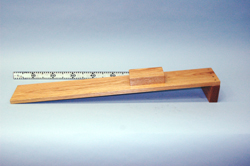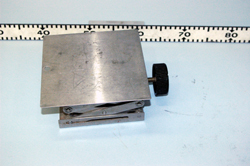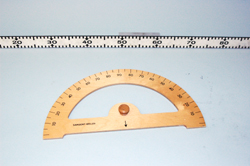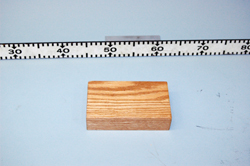|
Size: 2277
Comment:
|
← Revision 11 as of 2013-07-12 18:17:56 ⇥
Size: 2601
Comment: converted to 1.6 markup
|
| Deletions are marked like this. | Additions are marked like this. |
| Line 2: | Line 2: |
| ||<:30%>[:PiraScheme#Mechanics: Table of Mechanics Demonstration]||<:30%>[:MEEquipmentList: List of Mechanics Equipment & Supplies]||<:30%>[:Demonstrations:Lecture Demonstrations]|| | ||<:30%>[[PiraScheme#Mechanics| Table of Mechanics Demonstration]]||<:30%>[[MEEquipmentList| List of Mechanics Equipment & Supplies]]||<:30%>[[Demonstrations|Lecture Demonstrations]]|| |
| Line 7: | Line 7: |
| Applications of Newton's Laws, [:AppNewtonsLaws#Friction: 1K20 Friction] | Applications of Newton's Laws, [[AppNewtonsLaws#Friction| 1K20 Friction]] |
| Line 10: | Line 10: |
| * '''Cabinet:''' [:MechanicsCabinet:Mechanic (ME)] * '''Bay:''' [:MechanicsCabinetBayA1:(A1)] |
* '''Cabinet:''' [[MechanicsCabinet|Mechanic (ME)]] |
| Line 14: | Line 13: |
| attachment:PlaneSetup-400.jpg | {{attachment:PlaneSetup-400.jpg}} |
| Line 23: | Line 22: |
| ||apparatus||ME, Bay B1, Shelf #2|| || ||all other parts||ME, Bay B1, Shelf #2|| || ||...||ME, Bay B1, Shelf #2|| || |
||Inclined Plane||ME, Cubby C4|| || ||Block||ME, Cubby C4|| || ||Protractor||ME, || || ||Jack Stand||ME, || || |
| Line 34: | Line 34: |
| 1. Basically set out an inclined plane with this block or any other block. 1. Use a jack stand if desired or just slowly lift the inclined plane to allow the block to begin to slide down. 1. One can use a protractor to measure the Angle of Repose, if desired. |
1. Set out an inclined plane with the wood block or any other block. 1. Slowly lift by hand or use a jack stand if desired to slowly raise the plane until the block begins to slide down. 1. One can use a protractor to measure the angle of repose if desired. Using the jack stand in step 2 will help the accuracy of this step. |
| Line 44: | Line 44: |
| When the angle of the ramp becomes steep enough to overcome the frictional force between the bock and the plank due to the normal force of the block. Note: A free body diagram would be a good tool to describe the forces acting on the block before and after the block starts to slide. The block will then begin to slide down the ramp. When this occurs, the angle the ramp makes with the table is know as the Angle of Repose. This angle will differ depending on the normal force of the block(ie. it's mass) being used and the differences between the two surfaces (ie. it's coefficient of static friction). | As the angle of plane relative to the table is increased, there is less normal force on the block due to the plane and therefore less static friction between the block and the plane. An added effect is the increasing magnitude of the component of the force of gravity down the plane. The angle of repose is the critical angle where the gravitational force down the plane on the block is just enough to overcome the frictional force. This angle will differ depending on the normal force on the block being used(i.e. it's mass) and the material-dependent interaction between the two surfaces (i.e. the coefficient of static friction of the block). |
| Line 46: | Line 46: |
| ||attachment:IncPlane01-250.jpg||attachment:Platform01-250.jpg||attachment:Protractor02-250.jpg||attachment:Block01-250.jpg|| | Note: A free body diagram would be a good tool to describe the forces acting on the block before and after the block starts to slide. {{attachment:FreeBodyDiagram-250.png}} ||{{attachment:IncPlane01-250.jpg}}||{{attachment:Platform01-250.jpg}}||{{attachment:Protractor02-250.jpg}}||{{attachment:Block01-250.jpg}}|| |
| Line 49: | Line 53: |
| * [https://www.youtube.com/user/LectureDemostrations/videos?view=1 Lecture Demonstration's Youtube Channel] | * [[https://www.youtube.com/user/LectureDemostrations/videos?view=1|Lecture Demonstration's Youtube Channel]] |
| Line 53: | Line 57: |
| * List any references | * [[http://simple.wikipedia.org/wiki/Inclined_plane|Inclined Plane - Wikipedia]] |
| Line 56: | Line 60: |
| [:Instructional:Home] | [[Instructional|Home]] |
Angle of Repose, 1K20.35
Topic and Concept:
Applications of Newton's Laws, 1K20 Friction
Location:
Cabinet: Mechanic (ME)
Cubby: (C4)
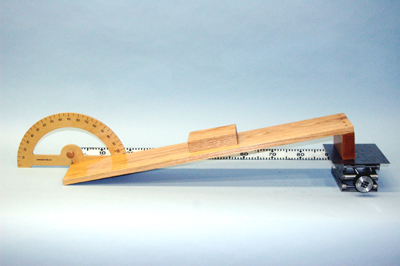
Abstract:
An inclined plane with a block resting on top is raised until the block begins to slide.
Equipment |
Location |
ID Number |
|
|
|
Inclined Plane |
ME, Cubby C4 |
|
Block |
ME, Cubby C4 |
|
Protractor |
ME, |
|
Jack Stand |
ME, |
|
Important Setup Notes:
- N/A
Setup and Procedure:
- Set out an inclined plane with the wood block or any other block.
- Slowly lift by hand or use a jack stand if desired to slowly raise the plane until the block begins to slide down.
- One can use a protractor to measure the angle of repose if desired. Using the jack stand in step 2 will help the accuracy of this step.
Cautions, Warnings, or Safety Concerns:
- N/A
Discussion:
As the angle of plane relative to the table is increased, there is less normal force on the block due to the plane and therefore less static friction between the block and the plane. An added effect is the increasing magnitude of the component of the force of gravity down the plane. The angle of repose is the critical angle where the gravitational force down the plane on the block is just enough to overcome the frictional force. This angle will differ depending on the normal force on the block being used(i.e. it's mass) and the material-dependent interaction between the two surfaces (i.e. the coefficient of static friction of the block).
Note: A free body diagram would be a good tool to describe the forces acting on the block before and after the block starts to slide.
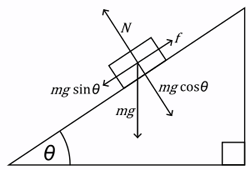
|
|
|
|
Videos:
References:
